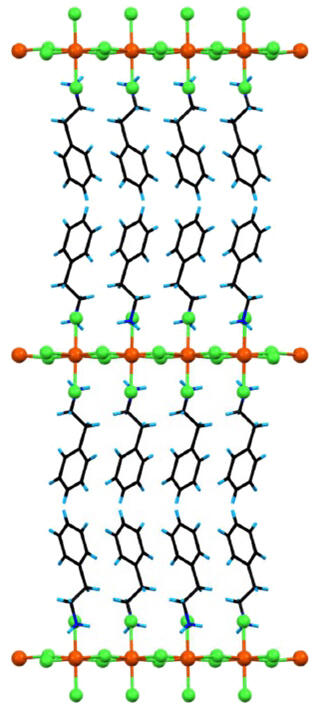A research group including Distinguished Professor Katsuya Inoue of the Graduate School of Advanced Science and Engineering at Hiroshima University, the University of Zaragoza (Spain) and Institut Laue-Langevin (France) announced on February 14 that they discovered the cause of the interaction between ferroelasticity and ferromagnetism in multiferroic materials, which are expected to be used in next-generation IT elements and energy-saving materials. This discovery was made possible by simultaneously measuring the ferroelastic and tilted antiferromagnetic transitions in a ferroelastic two-dimensional perovskite compound using powder neutron diffraction. This discovery will improve information density through its application to spintronics technology. The results have been published in the January 29 issue of the Journal of Materials Chemistry C, a journal of the Royal Society of Chemistry, UK.

Provided by Hiroshima University
Multiferroic materials are a group of materials combining multiple properties, such as ferromagnetism, ferroelectricity, and ferroelasticity, and are expected to be used in numerous devices. Major multiferroics include ferroelectric ferromagnets leveraging the magnetoelectric (ME) effect and ferroelastic ferromagnets exploiting the magnetostrictive (MA) effect. However, little research has been conducted on the physical properties of ferroelasticity in MA, and these properties have not been well understood.
Ferroelasticity is a state in which a crystal exhibits uniform lattice distortion, and the distortion state is inverted to another energy-equivalent state by applying stress. The ferroelastic state is usually characterized by a structural phase transition accompanied by a change in the crystal system. Two-dimensional perovskite compounds are transparent crystals; therefore, their ferroelastic state can be confirmed optically.
In 2017, the research group reported the ferroelastic transition of a two-dimensional perovskite compound "PEA-Fe," observing its spontaneous distortion in the in-layer direction at 160℃ (433 K), which is higher than room temperature. Additionally, when the temperature was further lowered, it underwent a magnetic transition to a tilted antiferromagnet at −175℃ (98 K). In this study, the researchers synthesized PEA-Fe and discovered that the elasticity and magnetism of this crystal were coupled. After confirming the two-dimensional perovskite structure of PEA-Fe via X-ray crystal structure analysis, powder neutron diffraction measurements revealed the coexistence of the ferroelastic and tilted antiferromagnetic orders. When this ferroelastic magnetic material was cooled under an external magnetic field, the magnetization curve shifted up and down. This shift was observed at temperatures lower than the magnetic transition temperature.
The study revealed that crystal distortion arising from ferroelasticity was transferred to the magnetic structure through spin-orbit interactions. This same set of interactions was also observed in chiral crystalline magnetic materials. It has been theoretically thought that chiral crystal distortion and magnetism lead to chiral helical magnetic structures by way of spin-orbit interactions. This phenomenon has now been experimentally demonstrated. Ferroelastic magnetic multiferroic materials containing magnetic ions with a large orbital angular momentum, in which the crystal strain and magnetic structure strongly interact, can be used as next-generation spintronic devices.
Inoue said, "It has been theoretically predicted that magnetic structures of materials, such as ferroelastic magnetic multiferroics and chiral magnetic materials, arise when atomic and ionic positional information, including crystal distortion and chiral crystal space group, is reflected in magnetism and their unique physical properties are coupled through the orbital angular momentum. This phenomenon has been clearly demonstrated experimentally. I expect a considerable increase in research on ferromagnetic multiferroics and chiral magnetic materials in the future."
Journal Information
Publication: Journal of Materials Chemistry C
Title: Coupling between ferroelasticity and magnetization in two-dimensional organic-inorganic perovskites (C6H5C2H4NH3)2MCl4 (M = Mn, Cu, Fe)
DOI: 10.1039/d4tc04445b
This article has been translated by JST with permission from The Science News Ltd. (https://sci-news.co.jp/). Unauthorized reproduction of the article and photographs is prohibited.




